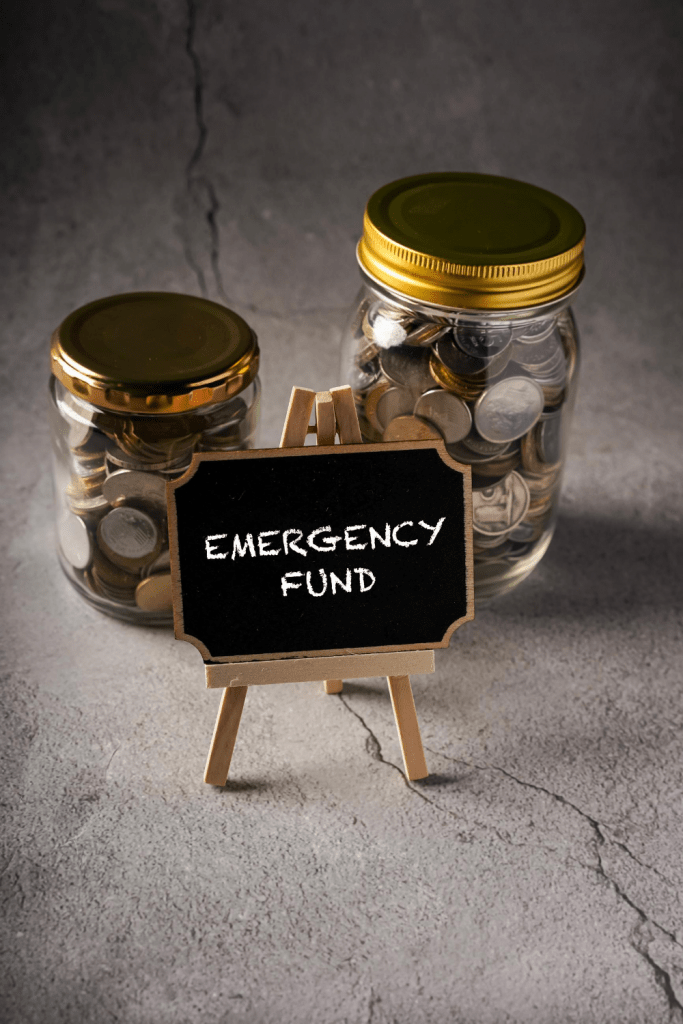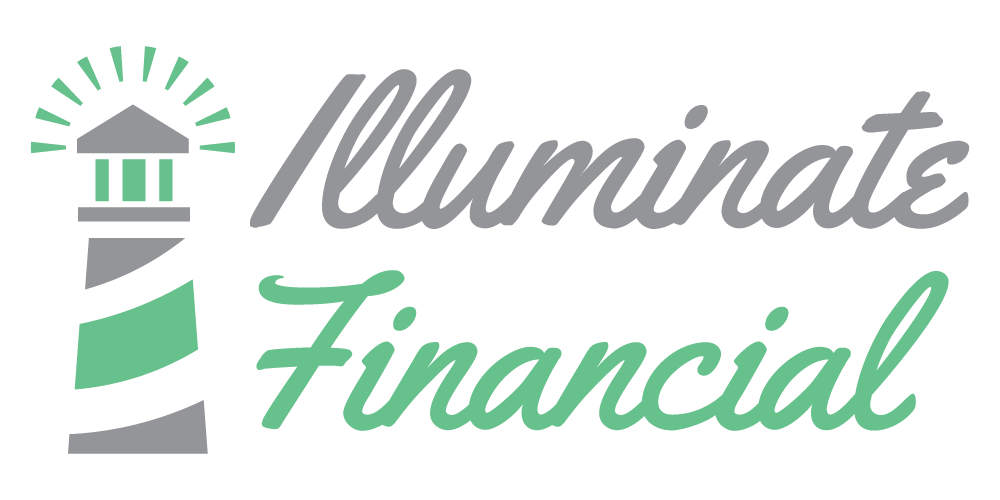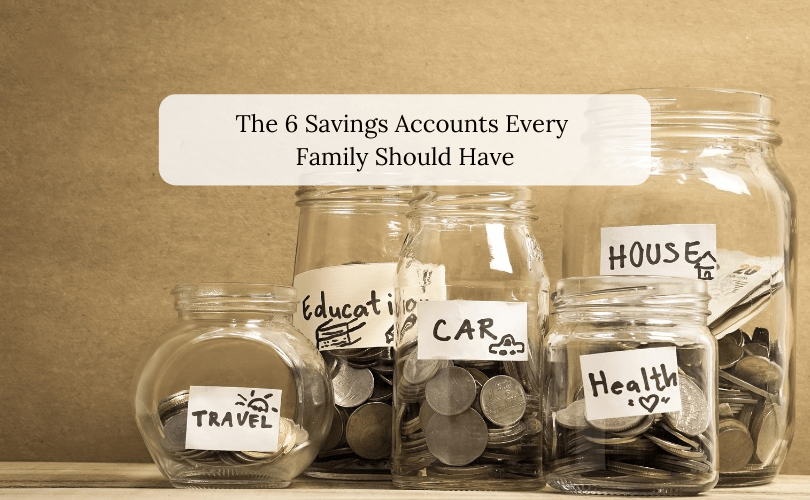We all know that it is so important to save money. But what specific accounts do you need? How do you know where to save them? And how can you figure out how much to save? Here is my list of six savings accounts, that at a minimum, every family should have
1. An Emergency Fund:

This particular savings account has been getting a lot of press lately due to the pandemic. Everyone should have an emergency fund. Your emergency fund is there in case things go very wrong. If you lose your job, get laid off, or can’t work due to a medical emergency, this money will pay your bills until you can get back to work.
I typically recommend that this fund should be equal to 3-6 months of take-home pay. But as we end our fifth month of the global Coronavirus pandemic, I am seeing people recommend that this fund have enough to cover 8-12 months of necessary expenses. It is tough to say exactly how much of a cushion everyone needs. But having some reserves stored up to help you in case of a dramatic change in income should always be a top priority.
Account Options
You can save your emergency fund in a regular savings account at your bank or in a high-yield savings or money market account. Just make sure that you have easy access to it when you need it!
2. A Sinking Fund:

A sinking fund is a savings account that you set up to help cover larger expenses that come up at a set time. These expenses can include things like property taxes or homeowner’s insurance premium you pay annually or twice a year. They can also include things like putting a new roof on your home in a few years, getting new tires next fall, or taking a spring break trip to Disney World. Personally, I have a separate sinking fund just for vacations, but either way works as long as you are planning ahead.
In order to determine how much you need to be saving into your sinking fund, you will want to take the cost of each expense (or a rough estimate) and divide it by the number of months until you need to make the purchase or payment. This will give you a monthly amount to save for that cost. Then each month make sure you are adding this amount to the account and when you have to pay the bill you will have the funds. A sinking fund makes it easier to budget for bigger planned or regular expenses. Instead of budgeting for it all at once months from now, you are taking care of it each month through savings.
Account Options
I recommend having your sinking fund in a high-yield savings account or a money market account where it can earn interest. Because you have a clearer idea of when you will need the money, it can be more removed from your regular checking account. And as they say ‘out of sight, out of mind’. Having these funds at a different bank may help you be less tempted to use them.
Sinking funds and emergency funds can often sound a bit similar. For a full comparison see my blog post on Sinking Funds vs. Emergency Funds.
3. A Medical Savings Account

Whether it is a check-up, prescription costs, or an unexpected illness, we all face medical costs each year. Each of these costs can really add up! So, it is important to have money set aside to take care of medical costs.
To figure out how much you need to set aside, look at your medical spending over the past year. Be sure to include insurance co-pays, out of pocket costs, the cost of prescriptions, and any other medical expenses. This should give you a good idea of roughly how much you need to save.
Account Options
To save money for medical expenses, you have a few options depending on the type of health insurance you have. If you have a high-deductible health plan (HDHP) through your employer, you can set up a Health Savings Account (HSA). According to Investopedia a HDHP is a plan that included an out-of-pocket maximum of no more than $6,750 for single coverage and $13,500 for family coverage in 2019. An HSA is a nice option because it is funded with pre-tax dollars. Money from a health savings account however, can only be used for qualifying medical expenses.
For an option with no limits on what medical expenses are covered, or if you don’t qualify for an HSA, open a high-yield savings account or money market account to save money to help pay for medical expenses.
4. A Gift Account

Holidays like Christmas and birthdays often seem to sneak up on us. And the cost of gift giving can really add up. This is why I recommend saving for holidays in a special account. To determine how much to save, allot a specific amount for each occasion and then total up all the occasions throughout the year. Divide this amount up across twelve months but make sure that you account for the withdrawals that will happen as holidays and birthdays come up.
Account Options
You can save this in its own savings account, in an envelope using cash, or even get buy gift cards each month to the retailers you frequent and use those to buy gifts down the road. How you save for gifts is less important than actually saving for them. These expense aren’t unexpected. But we treat them like they are, destroying our budget in the process!
5. A College Savings Account

College Tuition is increasing at an estimated rate of 8% a year. If you have kids, or even nieces and nephews, it is a good idea to start saving for college. The best time to start is when they are young because the longer you save the more you can take advantage of compound interest. Even if you don’t pay the full cost of college, having some money set aside can go a long way.
Account Options
There are many different options for where to save these funds. One option is a 529 College Savings Account. This is an investment account that is not taxed if it is used to pay for higher education and related expenses. Alternatively set up a Coverdell Education Savings Account, which is also tax advantaged. Both of these accounts have a penalty fee if the funds aren’t used for education and education related expenses. If the possibility that your child may not go to college worries you, you could set up an IRA to help pay for college expenses.
When saving for college, I recommend choosing the investment account that aligns most closely with your goals. These accounts will offer much larger growth potential than a high-yield savings account or money market account would. And because of their tax advantage status when used to pay for educational expenses, they really are the best route to take.
6. A Retirement Account

No matter where you are in the work force, you need to be saving for retirement. Even though retirement can seem like it is a long way off, it will be here before you know it. To make your retirement goals come true you want to leverage time and compounding!
Account Options
If your employer offers a retirement plan, I recommend starting there. See if they offer a contribution match if you put in a certain percentage of your salary. If so, add whatever contribution you have to do get the match! By not taking advantage of the match, you are leaving free money on the table.
If your employer doesn’t offer a retirement plan, or you want to set up an additional one, I recommend setting up a Roth IRA. Contributions are made after tax, withdrawals in retirement aren’t taxed which can be nice.
Final Thoughts
These are not the only savings accounts that you can choose to set up. Sometimes it is easier to have a savings account for each big goal. Find out what works best for you and what keeps you motivated and run with it. The important thing is that you are saving to cover both planned and unexpected events in the future!







